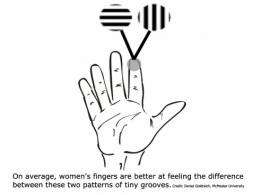Small Fingers More Touch Sensitive

When it comes to finger sensitivity, bigger isn't always better.
A guy who absentmindedly scratches his chin late in the day feels the stubble that has grown in since his morning shave. But if his girlfriend were to pass her hand along that same chin, there's a good chance that she would be better able to feel the individual hairs.
That's because women tend to have smaller fingers than men. According to a new study, smaller finger can sense the textures of tiny objects in greater detail than larger-sized digits.
To study differences between the sexes' sense of touch, Daniel Goldreich of McMaster University in Hamilton, Ontario recruited 100 college students to play a game of tactile whack-a-mole. Undergraduates placed their fingertips over a small hole where a cylinder with grooves carved into the top popped out and pressed against the skin. The student's job was to identify whether the grooves ran horizontally across or vertically up and down as they felt new cylinders with increasingly smaller grooves.
"If you use your fingers to explore a pimple or a scab or to rub the 'sleep' from the corner of your eyes after waking up, you are performing a tactile task that involves spatial dimensions similar to those of the grooves we used," said Goldreich.
Published in the latest issue of the Journal of Neuroscience, the data suggests that females are better at figuring out the orientation of the smallest grooves -- but mainly because they tend to have smaller hands. Females and males with similarly-sized fingers and hands showed similar abilities of detection.
"We found that the smaller someone's index finger is, the better sense of touch they have," said Goldreich. "I expect this study to take the tactile research community by surprise."
Goldreich believes that one of the secrets to a keen sense of touch comes from tiny skin-deep Merkel cells. These special cells are sparsely scattered all over the body in small groups and are present in greater numbers across touch-sensitive areas such as the fingertips and the lips. Discovered in 1875, the role of Merkel cells -- which seem to be located next to nerves that transmit fine-scale touch information to the brain -- has been debated ever since.
A few months ago, Ellen Lumpkin of Baylor College of Medicine in Houston provided strong evidence that we require Merkel cells in order to interpret Braille, compare rougher and finer grains of sand paper or manipulate strands of dental floss. She created mice with altered genes that grew and developed normally but lacked Merkel cells in certain parts of their bodies. The modified rodents could still feel vibrations, temperature changes and pain, but their nerve cells stopped responding to light touches.
Merkel cells are difficult to spot in a human finger. So instead of looking for them directly, Goldreich looked closely at the sweat glands on his subjects' fingertips, which are usually found above Merkel cells. He noticed that in larger fingers the sweat glands -- and presumably the Merkel cells beneath -- were spaced farther apart.
"This is exactly what we see in mice," said Lumpkin. "A smaller mouse has more densely packed Merkel cells than a larger one."
Like a digital camera with a higher megapixel resolution, the denser cells of smaller fingertips may really bring out the details in the "touching" snapshot sent to the brain.
© 2009 Inside Science News Service











